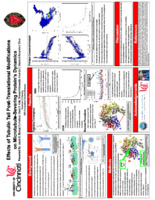Effects of Tubulin Tail Post-Translational Modifications on Microtubule-Severing Protein's Dynamics
Main Article Content
Abstract
By Jacob Stump, Chemistry; Maria Kelly, University of Cincinnati; Amanda Macke University of Cincinnati; Shehani Kahawatte, University of Cincinnati; Emma Meilinger, University of Cincinnati
Advisor: Ruxandra Dima
Award: Excellence in Research Communication
Presentation ID: 235
Abstract: Microtubules (MTs) are directional polymeric biofilaments used for structure, transport, and mechanical processes in the cell. They are made up of protein monomers called tubulin. MTs go through cycles of polymerization and depolymerization, a fact that leads to them being described as having dynamic instability. This is important for proper cellular functioning, as it allows for MTs to be directed as needed by the cell. Dynamic instability is regulated by a variety of proteins, each of which interact with the MTs directly through a tail-like region on the C-terminal of the tubulin monomers, known as the carboxy terminal tails or CTTs. An example of these proteins is spastin, an enzyme that hexamerically assembles along the MT and pulls on a CTT to sever tubulin dimers at a point along its length. The dynamics of these proteins seem to be mediated by the chemical make-up of CTTs, introducing an additional method by which the cell can regulate MTs besides at the genetic level. Due to a lack of dynamic resolution, understanding of the relation between CTT make-up and severing is unfortunately limited. In this project, we model and run all-atom molecular dynamic (MD) simulations of MT severing enzymes docked with various CTT sequences and post-translational modifications in order to study their effect on spastin dynamics. This will provide insight into how the MT encodes for and regulates the activity of these enzymes as well as how the cell regulates important processes.
